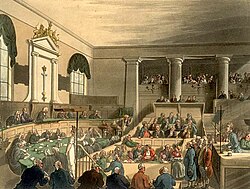උසාවිය
උසාවිය (court) යනු නීතියට අනුගතව to adjudicate legal disputes and dispense civil, criminal, or administrative justice සිදුකරීමට නෛතික බලයසහිත රජයේ [[ආයතනය]යි. [1]In common law and civil law states, courts are the central means for dispute resolution, and it is generally understood that all persons have an ability to bring their claims before a court. Similarly, those accused of a crime have the right to present their defense before a court.

Court facilities range from a simple farmhouse for a village court in a rural community to huge buildings housing dozens of courtrooms in large cities.
A court is a kind of deliberative assembly with special powers, called its jurisdiction, or jus dicere, to decide certain kinds of questions or petitions put to it. According to William Blackstone's Commentaries on the Laws of England, a court is constituted by a minimum of three parties, namely, the actor, reus, and judex[2], though, often, courts consist of additional attorneys, bailiffs, reporters, and perhaps a jury.
The term "court" is often used to refer to the president of the court, also known as the "judge" or the "bench", or the panel of such officials. For example, in the United States, and other common law jurisdictions, the term "court" (in the case of U.S. federal courts) by law is used to describe the judge himself or herself.[3]
In the United States, the legal authority of a court to take action is based on three pillars of power over the parties to the litigation: (1) Personal jurisdiction; (2) Subject matter jurisdiction; and (3) Venue.
Jurisdiction
Jurisdiction, meaning "to speak the law," is the power of a court over a person or a claim. In the United States, a court must have both personal jurisdiction and subject matter jurisdiction. Each state establishes a court system for the territory under its control. This system allocates work to courts or authorized individuals by granting both civil and criminal jurisdiction (in the United States, this is termed subject-matter jurisdiction). The grant of power to each category of court or individual may stem from a provision of a written constitution or from an enabling statute. In English law, jurisdiction may be inherent, deriving from the common law origin of the particular court.
Trial and appellate courts
Courts may be classified as trial courts (sometimes termed "courts of first instance") and appellate courts. Some trial courts may function with a judge and a jury: juries make findings of fact under the direction of the judge who reaches conclusions of law (called a jury trial) and, in combination, this represents the judgment of the court. In other trial courts, decisions of both fact and law are made by judges (called a bench trial). Juries are less common in court systems outside the Anglo-American common law tradition.
Civil law courts and common law courts
The two major models for courts are the civil law courts and the common law courts. Civil law courts are based upon the judicial system in France, while the common law courts are based on the judicial system in Britain. In most civil law jurisdictions, courts function under an inquisitorial system. In the common law system, most courts follow the adversarial system. Procedural law governs the rules by whichcourts operate: civil procedure for private disputes (for example); and criminal procedure for violation of the criminal law.
Tribunal

.
See also
General
- Sanctions (law)
- International judicial institution
- International Criminal Court
- List of people who have acted as their own attorney
- Court security
Types and organization of courts
- Appellate court
- Constitutional Court
- Court of Faculties
- Court-martial
- Courts of England and Wales
- Ecclesiastical court
- Equity court
- Family court
- High Court of Justiciary
- Revolutionary Tribunal (French Revolution)
- Scots Law
- Scottish Court Service
- ශ්රේෂ්ඨාධිකරණය
- Trial court
Notes
බාහිර සබැඳි
- US federal courts
- Courtprep සංරක්ෂණය කළ පිටපත 2012-03-05 at the Wayback Machine, Information about the Canadian justice process, features an interactive courtroom and witness tips.
